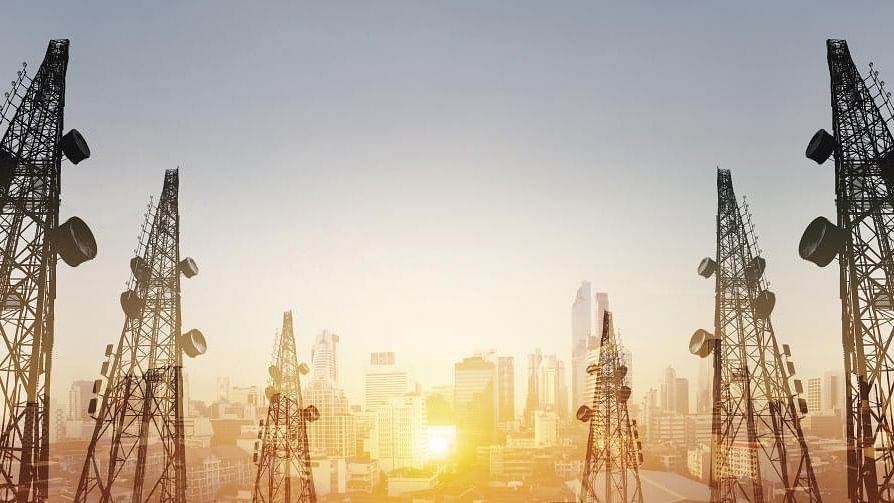
Representative image of mobile towers.
Credit: Getty Image
Bengaluru: Though Bengaluru is known as the IT hub, it is still plagued by mobile network connectivity issues. People often complain of poor connectivity, especially in densely populated areas, indoors and areas surrounding defence establishments. While connectivity issues point to a need for better infrastructure, government policies and other issues have been hurdles in the way of infrastructure providers.
According to data accessed by DH, in the last 10 years, close to 45 per cent of the Right of Way (RoW) applications in the Bengaluru Urban district have been rejected. While 34 per cent of them have been accepted, the rest are pending. RoW is the basic permission required to roll out any digital infrastructure (including mobile towers and OFC cables).
A senior official from the Department of Telecommunication (DoT) told DH on condition of anonymity that a portion of the applications that were shown as rejected were moved to the rejected bin since they could not be brought under the deemed permission system that was introduced a month back. “Till recently, Bruhat Bengaluru Mahanagara Palike (BBMP) and their counterparts responsible were not disposing of the applications on time, and hence, a new deemed permission system was introduced to ensure applications are processed within 60 days. Since a few pending applications could not be brought under the system, they had to be marked rejected,” the official explained.
While the delay in providing permissions is one problem, a few other applications were also rejected owing to the state government policies, the official explained. For instance, according to a notification by the Urban Development Department, mobile towers cannot be erected in the bed of water bodies, within a 100 m radius of protected monuments, and a 50 m radius of schools, hospitals, and religious structures. This could make the process of identifying suitable locations a challenge.
Infrastructure providers also pointed out that the charges levied by the state government and the lack of facilities were hindering the process of establishing better digital infrastructure for the city. “Non-uniform charges, high underground optical fibre laying costs, and the lack of a common duct facility in Bengaluru complicate the infrastructure deployment process,” T R Dua, Director-General, Digital Infrastructure Providers Association (DIPA), told DH.
Dua added that Bengaluru also faces unique challenges in providing telecommunications connectivity due to high population density, interference from buildings and trees, weather conditions, cable cutting and opposition from local communities.
Acknowledging that the system of providing approvals and the government policies needed intervention, a senior official from the Urban Development Department (UDD) told DH that the department is in the process of constituting a single body to oversee the entire process. "We do understand that there have been a few issues. We are in the process of constituting an integrated body to regulate the process. There are multiple stakeholders involved, the system will take time to stabilise," the official said.
While connectivity issues in newly developed areas and outskirts could be owing to the lack of infrastructure, network issues in the heart of the city can be attributed to two major reasons, an official from the Telecom Regulatory Authority of India (TRAI) explained. "One, in thickly populated areas and areas where buildings are constructed close to each other, there is a problem since the operators are not able to match the demand. However, in open spaces in the heart of the city, the problem is that the infrastructure providers have restricted access to defence areas," the official explained.
While the infrastructure providers need multiple levels of permission to set up towers, maintenance is an issue since they require 24/7 access to the tower and the defence authorities only provide access as required," the official explained.
However, officials from the UDD said that they are trying to hold discussions with the defence authorities to get the required permissions. "The infrastructure providers have sought our help in this regard. We will discuss the issue with the defence authorities and see how we can strike a balance between security and need for infrastructure," the official said.
TRAI, DoT monitoring service quality
TRAI and DoT officials said they are monitoring the quality of service in areas where there is coverage. "However, we cannot force them to set up infrastructure if it is not financially viable," a senior DoT official said. Officials added that it was difficult to ensure service in thickly populated areas and indoors owing to the rapid growth of the city. "In such cases, we suggest that consumers use in-building solutions for better connectivity," the official said.
What are the constraints?
Large parcels of defence land with restricted access to lay and maintain towers
Delay in processing of RoW applications
Government policies like restrictions on locations, non-uniform fees, high charges to lay OFC cables
High population density
RoW application status in Bengaluru Urban District between 2013 and 2023
Total: 10,814
Approved: 3,694
Rejected: 4,890
Pending and under processing: 2,230